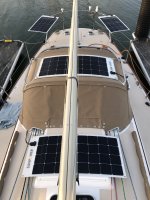Hello folks-
I saw someone here (sorry, can't find the post now*) who mentioned using their engine to charge during the SHTP, then... having to rebuild the top end after the race, having trashed the engine by running it under no prop load (only to charge). They seemed to view this is the cost of doing business in the SHTP. I cannot afford to wreck an engine, and have always been told not to run it except under load (i.e., with prop engaged)... but the electrician I'm working with said this was crazy; I shouldn't run the engine at 3000 rpm with no load (it's a Yanmar 3GM30F), but 1800 or 2000 rpm to charge wouldn't wreck the engine and will charge fine.
Is this correct? Obviously, if I can use the engine without destroying it, then I only need solar as a backup. That I can handle.
If someone would, let me know if one can actually charge using the engine without damaging the engine (and if so, what are the trick(s) to avoid damage -- is it just running at 2000 rpm for a Yanmar? Does running at low rpm risk carbon build-up?)
I know everyone probably knows this stuff, but I don't, and a thread search did not turn up the answer (other than that clearly some people clearly use engines for charging.)
Any information/tips appreciated.
PS: I am (very) slowly getting my boat in shape for offshore stuff, and am doing some electrical (charging) stuff right now, which brought this question off the back burner.
* This isn't the post I remember, but @AZ Sailor indicates similar issues:
"ended up putting a lot more run time on the Yanmar 3YM30 power plant than planned. I don't have my log book handy so I can't tell you the total hours, but it might have been twice what what was planned -- so for my 17-day passage, maybe 30 hours or more. This was really not good for the engine. Then, in the inevitable slow down in usage after getting back from HI, things got worse. The injector nozzles fouled and the mixing elbow became so constricted I was surprised the thing even ran at all."
Morning Star's electrical budget for the 2018 race predicted almost one hour of engine time to charge every day. And that was expecting 7 hours/day of sunshine on rigid solar panels with a total of 225 watts. We had little sunshine for the first 10 days or so, and not a lot over all, and ended up putting a lot more run time on the Yanmar 3YM30 power plant than planned. I don't have my log book handy so...
I saw someone here (sorry, can't find the post now*) who mentioned using their engine to charge during the SHTP, then... having to rebuild the top end after the race, having trashed the engine by running it under no prop load (only to charge). They seemed to view this is the cost of doing business in the SHTP. I cannot afford to wreck an engine, and have always been told not to run it except under load (i.e., with prop engaged)... but the electrician I'm working with said this was crazy; I shouldn't run the engine at 3000 rpm with no load (it's a Yanmar 3GM30F), but 1800 or 2000 rpm to charge wouldn't wreck the engine and will charge fine.
Is this correct? Obviously, if I can use the engine without destroying it, then I only need solar as a backup. That I can handle.
If someone would, let me know if one can actually charge using the engine without damaging the engine (and if so, what are the trick(s) to avoid damage -- is it just running at 2000 rpm for a Yanmar? Does running at low rpm risk carbon build-up?)
I know everyone probably knows this stuff, but I don't, and a thread search did not turn up the answer (other than that clearly some people clearly use engines for charging.)
Any information/tips appreciated.
PS: I am (very) slowly getting my boat in shape for offshore stuff, and am doing some electrical (charging) stuff right now, which brought this question off the back burner.
* This isn't the post I remember, but @AZ Sailor indicates similar issues:
"ended up putting a lot more run time on the Yanmar 3YM30 power plant than planned. I don't have my log book handy so I can't tell you the total hours, but it might have been twice what what was planned -- so for my 17-day passage, maybe 30 hours or more. This was really not good for the engine. Then, in the inevitable slow down in usage after getting back from HI, things got worse. The injector nozzles fouled and the mixing elbow became so constricted I was surprised the thing even ran at all."
I finally got around to measuring all the loads and preparing an offshore electrical budget.
Your comments are encouraged. What did I forget, or what looks out of whack? Thanks!
Morning Star's electrical budget for the 2018 race predicted almost one hour of engine time to charge every day. And that was expecting 7 hours/day of sunshine on rigid solar panels with a total of 225 watts. We had little sunshine for the first 10 days or so, and not a lot over all, and ended up putting a lot more run time on the Yanmar 3YM30 power plant than planned. I don't have my log book handy so...
Last edited:


